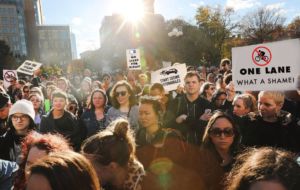Traffic Congestion From Bike Lanes Could Be An Emergency

Minneapolis city officials’ mania for bike lanes could be an emergency. That’s the diagnosis by Dr. Geoffrey Emerson in the Star Tribune in the latest cry for help from drivers stuck in traffic on city streets with wide open, empty bike lanes near Abbott Northwestern and Children’s Hospital.
A downside to bicycle lanes is that they come at the expense of existing traffic lanes, thereby increasing congestion for vehicles. This is especially apparent on 26th Street and 28th Street in south Minneapolis, where traffic slowed to a crawl on Tuesday.
These bike lanes were opened shortly before the nearby Franklin Avenue bridge was closed for construction, redirecting additional traffic onto 26th and 28th. For local Abbott Northwestern Hospital and Children’s Hospital, the gridlock has major implications because patients are transported to the hospitals and clinics via vehicles including ambulances, Metro Mobility and, in the case of pediatric patients, rides from their parents.
Dr. Emerson acknowledges bicycling has its up side. But he’s also pragmatic about the fact that cars and other vehicle far exceed the number of bikes on the road.
During my morning commute on Tuesday, there was not a single bicyclist using the 28th Street bike lane between Hennepin and Portland avenues S. Meanwhile, vehicle traffic was in gridlock in the adjacent vehicle lanes.
A downside to bicycle lanes is that they come at the expense of existing traffic lanes, thereby increasing congestion for vehicles. This is especially apparent on 26th Street and 28th Street in south Minneapolis, where traffic slowed to a crawl on Tuesday.
Will it take an emergency to wake up Minneapolis city planners? A tragedy resulting from an ambulance tied up in traffic?
As traffic inched along during my morning commute this week, I wondered what would happen if an ambulance needed to get to the hospital. I suppose it could drive along the empty bike path. Even so, I believe the bike lane on 28th Street is counterproductive and should be discontinued.
There are overwhelming demands on the vehicle lanes in this area due to the Franklin Avenue bridge closure, transport to busy nearby medical facilities and reduced demand for bike lanes during winter.
The diagnosis? Fewer bike lanes, particularly in fall and winter months–just what the doctor ordered.